
95% of researchers rate our articles as excellent or good
Learn more about the work of our research integrity team to safeguard the quality of each article we publish.
Find out more
ORIGINAL RESEARCH article
Front. Psychol. , 23 September 2020
Sec. Psychology of Language
Volume 11 - 2020 | https://doi.org/10.3389/fpsyg.2020.02130
This article is part of the Research Topic Behavioral and Neurophysiological Approaches to Code-Switching and Language Switching View all 19 articles
The contentious question of bilingual processing cost may be recast as a fresh question of code-switching (CS) strategies—quantitative preferences and structural adjustments for switching at particular junctures of two languages. CS strategies are established by considering prosodic and syntactic variables, capitalizing here on bidirectional multi-word CS, spontaneously produced by members of a bilingual community in northern New Mexico who regularly use both languages (Torres Cacoullos and Travis, 2018). CS strategies become apparent by extending the equivalence constraint, which states that bilinguals avoid CS at points of word placement conflict (Poplack, 1980), to examine points of inconsistent equivalence between the languages, where syntactic difficulty could arise. Such sites of variable equivalence are junctures where the word strings of the two languages are equivalent only sometimes due to language-internal variable structures. A case in point for the English-Spanish language pair is the boundary between main and complement clauses, where a conjunction occurs always in Spanish but variably in English. The prosodic distancing strategy is to separate the juncture of the two languages. Here the complement clause appears in a different prosodic unit from the main clause—disproportionately as compared both with monolingual benchmarks and with bilinguals’ own unilingual English and Spanish. Prosodic distancing serves to mitigate variable equivalence. The syntactic selection strategy is to opt for the variant that is more quantitatively available and more discourse neutral. Here the preference is for the Spanish complementizer que—regardless of main or complement clause language. This is the more frequent option in bilinguals’ combined experience in both their languages, whereas the English complementizer that is subject to a number of conditioning factors. Syntactic selection serves to restore equivalence. Discovery of community CS strategies may spur reconsideration of processing cost as a matter of relative difficulty, which will depend on bilinguals’ prosodic and syntactic choices at particular CS sites.
Code-switching (CS) may be defined as stringing together two languages in alternation. In (1), for example, the speaker begins the sentence in Spanish, continues in English, and ends in Spanish (In the examples, stretches of speech originally produced in English are italicized in the translation on the right.) CS is generally agreed to be orderly, though debate continues over the rules governing it (Poplack, 2015: 918). The notion that CS incurs blanket processing cost, however, is contentious (see Johns et al., 2019: 585–587 for a review). In this article, the question of cost is refashioned into an investigation of bilingual CS strategies. We establish prosodic distancing and syntactic selection strategies, capitalizing on CS data by members of a bilingual speech community who regularly use both languages. CS strategies are discoverable in speakers’ structural choices, as revealed by distribution patterns in the spontaneous production of CS.

Though psycholinguistic studies resting on a range of behavioral and brain imaging measures widely report CS costs, the extent and even applicability of CS cost is controversial. One issue is that cost may pertain to cued rather than natural production, as when participants are required to name items (for a review of the language switching experimental paradigm see, e.g., Litcofsky and Van Hell, 2017: 113). Yet more generally, findings of bilingual processing costs are increasingly acknowledged to be contingent on study participants, experimental design and language mixing type.
First, as concerns participants, a crucial factor is linguistic experience with CS, which modulates presumed cognitive costs. Studies with university student participant pools tend to privilege relative language proficiency as assessed via formal tests and questionnaires (rather than language use as observed via a sociolinguistically constructed corpus). Yet cognitive-neurological consequences of bilingualism, for example, involving executive control, are likely affected by what has been called “the behavioral ecology of bilingual speakers” (Green, 2011: 1) or “participants’ code-switching habits” (Hofweber et al., 2016: 648). In particular, processing costs may “depend on the frequency of code-switching in the bilingual community” (Adamou and Shen, 2019: 53). Because “the behavior of an individual can be understood only through the study of the social groups of which he or she is a member” (Labov, 2010: 7), the question of bilingual linguistic experience thus becomes one of discovering speech community norms for CS.
Second, reported CS costs depend on experimental design. The tasks asked of participants, but also the stimuli and the way they are presented, turn out to be pivotal. For example, an eye-tracking study reported greater processing difficulties when participants were asked for an acceptability judgment on the code-switched sentence they had read than when they were asked a comprehension question about the sentence’s content (Guzzardo Tamargo, 2012; Beatty-Martínez et al., 2018: 9). In a word recognition task, reaction times were found to be similar with verbs in mixed sentences from other languages as with the verbs in unilingual sentences, for members of a community where other-language verb insertions occur regularly in everyday speech; in contrast, “ecologically non-valid” stimuli yielded slower reaction times (Adamou and Shen, 2019: 66). At the same time, even for “valid” stimuli, the manner of presentation affects the outcome. For example, a mixed mode with unilingual and code-switched sentences resulted in shorter processing times than a blocked mode with an all-unilingual block and an all-code-switches block. This result would be consistent with natural production, in which “intra-sentential code-mixing does not occur for long stretches of time and is broken up by unilingual discourse” (Johns et al., 2019: 584).
Third, for language mixing type, a key consideration is the extent of the material from the other language. Most neurocognitive studies reporting switching costs have been restricted to single-word other-language items (as noted by, e.g., Litcofsky and Van Hell, 2017: 113–115), giving short shrift to multi-word string combinations or CS of the “alternational” type (Muysken, 2015: 259).
In sum, despite an abundance of lab-based studies, assessing CS cost is far from a settled matter. Here we shift perspectives, recasting the question of cost as one of CS strategies to contribute findings from actual performance, relying on a well-defined bilingual community, the data of everyday speech and a uniquely large sample of multi-word CS. It has been proposed that CS serves as a general “strategy for optimizing task performance” (Beatty-Martínez et al., 2020). We propose to identify particular CS strategies, by considering the role of prosodic and syntactic variables.
CS cost may be viewed as a matter of degree. Such an approach parallels psycholinguistic findings for degrees of processing difficulty in monolingual language use. For example, English object relative clauses (They were good herring that we got) are less frequent than subject relatives (It’s your arteries that fur up), on a scale of approximately 3 to 1 in everyday speech (Tagliamonte et al., 2005: 87). Object relatives are also more difficult to process. But the difficulty is modulated by both online contextual features (such as animacy of the head noun) and cumulative linguistic experience with object relatives (statistical learning) (e.g., Wells et al., 2009: 87; Hsiao and MacDonald, 2016: 250). Following from a view of difficulty as a relative concept, instead of assuming blanket CS cost as compared with monolingual processing, CS may be more difficult at some junctures of the two languages than at others.
CS strategies are seen in the preferences for CS at particular sites and the ways of dealing with those CS sites that are not preferred. We thus define CS strategies as quantitative preferences and structural adjustments for CS at particular junctures of the two languages. CS theories have been mostly concerned with constraints on CS, that is, permissible CS sites. From the perspective of CS strategies, however, the twin questions are the following: (1) Of the permissible sites, are there ones bilinguals actually prefer? (cf. Sankoff and Poplack, 1981: 37) and (2) How do bilinguals treat prosodic and syntactic boundaries at the junctures of their two languages?
In order to identify CS strategies, we focus on multi-word strings from two languages within an integrated sentence, or intra-sentential CS (cf. Poplack, 1980: 589). This is because syntactic difficulty should be minimal for alternating entire sentences, for example, in response to a change in topic or interlocutor.
How are sentences delimited in speech? The quality of the transcription of speech corpora is often a serious drawback. A well-established replicable method is based on the Intonation Unit (IU), a segment of speech produced with “a single, coherent intonation contour” (Du Bois et al., 1993: 47; see Appendix 3 for acoustic features)2. In the example of spontaneously produced CS in (1) above, each line of transcription represents an IU. Punctuation at the end of each line represents types of transitional continuity between IUs. A comma indicates “continuing” intonation, projecting more to come, as in (1a) and (2a), (2b) below, while a period marks “final” intonation—a fall to low pitch—as in (2c), and a question mark, “appeal” —a high rise in pitch—as in (1b) (Du Bois et al., 1993: 52–55). See Appendix 1 for transcription conventions.
Intra-sentential CS is operationalized for spoken discourse on the basis of the “prosodic sentence,” illustrated in (2): one or more clauses in one or more IUs, the last of which ends in intonational completion, represented by a period or question mark (Chafe, 1994:139–140). Inter-sentential CS may be inter- or intra-clausal (Deuchar, 2020: 2). Within the prosodic sentence in (2), the first switch in line (a) is inter-clausal (at the juncture of two adverbial clauses), while the CS between lines (b) and (c) is intra-clausal (at the juncture of adverb and negated finite verb within a single clause).

Prosodically based transcription is particularly handy for identifying CS patterns. In (2), note that the first instance of CS occurs within the IU [in line (a)] and the second at IU boundaries [between lines (b) and (c)]. We now know that CS is more frequent at the boundary of prosodic units (captured here across lines) than within them (Torres Cacoullos and Travis, 2018: 51–52; cf., Mettouchi, 2008: 195; Shenk, 2006: 189; Steuck, 2018). Intra-sentential multi-word CS in the NMSEB corpus occurs at a rate that is approximately three times greater across IUs than within IUs (in aggregate across different syntactic boundaries, where the universe is the total number of IUs eligible to host CS) (Torres Cacoullos and Travis, 2020).
Over the years, many CS theories have appealed to some notion of equivalence or congruence between languages (e.g., Deuchar, 2005: 255; Lipski, 1978: 257–258; Muysken, 2015: 259). Of the many available theories of CS, the equivalence constraint (Poplack, 1980: 58l) is readily operationalizable into predictions that can be tested in a corpus of bilingual speech. In addition, it neither assumes that bilingual patterns need be derivable from syntactic principles for monolingual grammar nor depends on theory-internal postulates and thus may facilitate comparisons across studies.
The equivalence constraint states that CS tends to occur at syntactic boundaries present in both languages, or conversely, CS is avoided at points of word placement incompatibility between the two languages (Poplack, 1980: 586; Sankoff, 1998: 46–47). Proposed and operationalized in Poplack’s (1980: 590–595) community-based study of spontaneously produced CS, this simple constraint accounted for nearly all occurrences. Fewer than 1% (n = 11/1,835) of switches occurred at points where the word orders of the two languages were different (Poplack, 1980: 611). Also argued to be consistent with equivalence as a condition on CS are findings for cross-language syntactic priming, which is favored when word order is homologous across languages (e.g., Loebell and Bock, 2003: 227; Kootstra et al., 2010: 808).
To illustrate for English and Spanish, let us take adjectives as a site of CS (3). Attributive adjectives tend to occur post-nominally in Spanish but are prenominal in English. CS between attributive adjective and noun is restricted (largely to a small set of prenominal Spanish adjectives), whereas there is a propensity to switch before a predicative adjective—a point at which the languages are compatible (Sankoff and Poplack, 1981: 33). Even among equivalence sites, though, there may be preferences. For example, the boundary between verb and lexical object shows a somewhat higher CS rate than that between lexical subject and verb (Sankoff and Poplack, 1981: 35; cf. Poplack, 1980: 604).
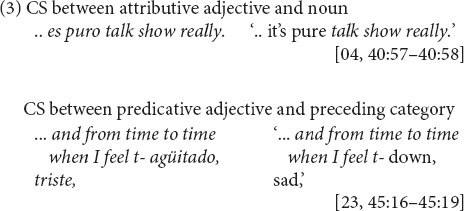
CS strategies may be most clearly observed where syntactic difficulty could arise, at points of inconsistent compatibility, or sites of variable equivalence. These are points where the word strings of the two languages are equivalent only sometimes, at syntactic boundaries that occur variably in one or both of the languages (Torres Cacoullos and Poplack, 2016). How do bilinguals deal with CS at sites of variable equivalence? The answers will allow us to discern structural adjustments for CS at particular junctures of the two languages.
The juncture between main and complement clause, illustrated in (4) and (5), is a site of variable equivalence for English-Spanish bilinguals. This is because of the inconsistent compatibility between English and Spanish in the presence of the complementizer. In English, complementizer that is present only sometimes. Rates of complementizer that presence range approximately between just 10% and 30% in corpora of spoken English (e.g., 9%, n = 4,106, Tagliamonte and Smith, 2005: 299; 21%, n = 2,820, Torres Cacoullos and Walker, 2009: 20; 34%, n = 3,681, Wulff et al., 2018: 105). Complementizer absence, as in (6), is thus the majority variant. (In the examples, absence of that is indicated with a Ø between the main clause [MC] and the complement clause [CC]3.)
In Spanish, in contrast, the complementizer que is present, as in (7), virtually always (Silva-Corvalán, 1994: 137). An exception is particular well-wishing formulaic expressions (as with first person, present-tense espero ‘I hope’) (Rodríguez Ricelli, 2018: 323–327). Thus, due to language-internal structural variability, complementizer presence is not an equally probable choice across the two languages. The differing probabilities of the analogous options (that, que) within each language make the main and complement clause boundary a site of variable equivalence for CS between the languages.
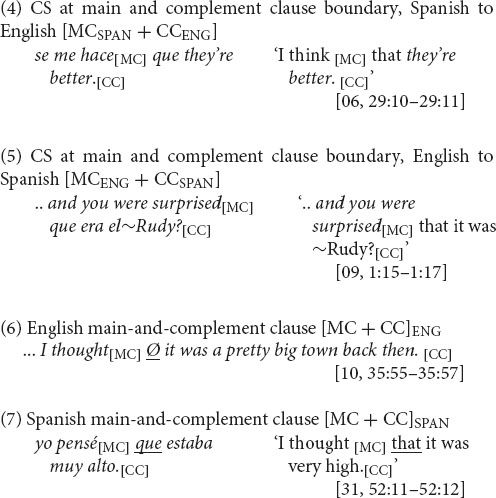
The main topic sparked by CS between main and complement clauses has been the language of the complementizer, in other words, whether the switch is after the complementizer, remaining in the language of the main clause, or at the complementizer, initiating the switch to the language of the complement clause.
Proposals have swung according to the prevailing formal syntactic theory (see Pérez-Leroux et al., 2014: 284–285, 291 for a summary), on the assumption that bilingual, CS-particular rules are unwarranted (e.g., Vergara, 2018: 234 and references therein). For example, the complementizer has been argued to be in the language of the main clause verb, under the notion of a “government” relation between sentence constituents (Di Sciullo et al., 1986). The contrary claim has also been made, that switching is banned between the complementizer and the subordinate clause, based on the notion of a “functional head” (Belazi et al., 1994). Under a newer Chomskyan notion of “phase,” the prohibition against switching between complementizer and complement clause would hold for certain (“plain featureless”) complementizers (e.g., “that” vs. “since”) (López et al., 2017: 9–10).
Violations of such principles have been handled by a model for bilingual phenomena in which complementizers come from the Matrix Language (ML). Thus, with Spanish-English CS, both possibilities are allowed as long as the ML is identified accordingly: [MCSPAN + que + CCENG] and [MCENG + that + CCSPAN], where the ML is that of CP1, as well as [MCSPAN + that + CCENG] and [MCENG + que + CCSPAN], where the ML is that of CP2 (Myers-Scotton and Jake, 2009: 352; CP = Complementizer Phrase). Taken to support a ML account, for example, has been Igbo-English CS, where the complementizers are in the language of the (Igbo) main clause (Ihemere, 2016: 177–178), but also literary Spanish-English CS, where a “majority” of complementizers are in the language of the complement clause (Callahan, 2004: 50).
Another topic has been the appearance of the Spanish complementizer que in an otherwise unilingual English sentence, as in I always got the feeling, que he was never comfortable. [15, 38:04–38:07]. Lone other-language complementizers may be borrowed (Matras, 2009: 287; Joseph, 2016: 196) or on a “continuum from borrowing to CS” (Treffers-Daller, 2005: 500), an instance of “leaks” (Bentahila and Davies, 1998: 42) or of “congruent lexicalization” (Muysken, 2015: 244–247). Socially, such items may be ethnic identity markers (Pfaff, 1979: 314, referencing Gumperz and Hernández-Chávez, 1975: 156–157 on interjections and connectors). Lone complementizer que must be dealt with elsewhere, here appearing sparsely (n = 7 tokens vs. n = 467 unilingual English sentences in which it could have appeared, produced by 5 of 40 speakers (see Data)).
This embarrassment of proposals brings us to the question of data sources and test criteria. In the following, rather than selected counterexamples to categorical constraints, we look to quantitative patterns and speaker preferences.
We entertain the following hypotheses about bilingual strategies at sites of variable equivalence:
Mitigate variable equivalence by prosodically separating the juncture of two languages.
Construct consistent equivalence by opting for the more readily available syntactic variant.
According to the prosodic hypothesis, bilinguals use prosody to distance CS boundaries at sites of variable equivalence. This is based on the generalization that there is a tighter syntactic relationship between words in the same Intonation Unit (IU) than between words positioned in different IUs (Croft, 1995: 849–864). For example, while main clauses tend to appear in separate IUs from one another, as in (1), complement clauses tend to be prosodically integrated in the same IU with their main clauses (Croft, 1995: 861). This is true for both English and Spanish, that is, main and complement verbs tend to occur in the same IU, as in (6) and (7) above4. The prosodic hypothesis predicts that the prosodic integration of main and complement clauses will diminish when CS occurs between them.
The syntactic hypothesis states that bilinguals create consistent equivalence for CS at sites of variable equivalence. How? In the case of variable complementizer presence, they would restore equivalence by using a complementizer, eschewing the complementizer absence option. Now, whether complementizers remain in the language of the main clause or initiate the switch into the language of the subordinate clause (see preceding section), in switching to or from Spanish, bilinguals would use English that at a higher rate than in monolingual English main-and-complement clause structures. Conversely, they may prefer the Spanish complementizer que, regardless of CS direction. If so, the prediction is for a predominance of [MCENG + que + CCSPAN] and [MCSPAN + que + CCENG], as in (4) and (5) above, over [MCENG + that + CCSPAN] and [MCSPAN + that + CCENG].
To verify bilingual strategies, the procedure is to extract all tokens of CS at a particular site and compare their behavior with those of unilingual and monolingual counterparts at the CS-hosting site. Let us first contextualize the data.
The New Mexico Spanish-English Bilingual (NMSEB) corpus consists of 31 recordings (2010–2011) with 40 members of a long-standing, non-immigrant, bilingual community, all speakers who regularly use both their languages (Torres Cacoullos and Travis, 2018: 13–73). Spanish and English have coexisted as the main competing languages for over 150 years in the northern region of New Mexico, a United States southwestern state (Bills and Vigil, 2008: 29–47). The speakers of the NMSEB corpus are Hispanic New Mexicans, 23 women and 17 men, born between 1923 and 1989. They include mineworkers, ranchers, and a variety of service employes, and most (29/40) live in rural areas.
The participants are members of a speech community, a group of individuals sharing “well-defined [geographic] limits, a common structural base and a unified set of sociolinguistic norms” (Labov, 2007: 347). As an established bilingual speech community, they also share unified conventions for combining their languages (Torres Cacoullos and Travis, 2018: 25). As an example of bilingual community norms for combining languages, consider the preferred way to incorporate English-origin verbs into Spanish. This is with light verb hacer ‘do,’ e.g., lo hic-ieron [do-PFV.3PL] hire ‘they hired him,’ in New Mexican, but not in Puerto Rican, Spanish (cf. Wilson and Dumont, 2015: 450–451).
Community norms, furthermore, may impact the neurology of language control (Green, 2011: 2). One dimension is degree of bilingualism. CS cost has been associated with language dominance and thus imbalance in switching direction—from L1 to L2 vs. L2 to L1 (e.g., Pérez-Leroux et al., 2014: 303–307). Dominance in turn has been inferred from self-rating scales, language history questionnaires, standardized proficiency tests, and online measures such as from picture naming or verbal tasks (for a review of the construct, see Treffers-Daller, 2016). Alternatively, dominance may be viewed through frequency and domains of use of two languages (Treffers-Daller, 2019: 385–388). For the NMSEB corpus, the scores for, and lack of correlation between, language preference, self-rating, and predominance (proportion of clauses produced in each language) give no ground for designating either English or Spanish as the dominant language (Appendix 2). The participants are highly bilingual, as validated in the aggregate by the stretches of English and Spanish in even amounts (Torres Cacoullos and Travis, 2018: 57–73).
Moreover, seamless CS corroborates the speakers’ bilingualism. Northern New Mexico bilinguals may change languages with no particular rhetorical or interactional motivation (Torres Cacoullos and Travis, 2018: 67–71). In such “intra-situational” CS, the two languages are brought together in a single speech event, with no change in interlocutor or topic, that is, no external trigger (Poplack, 2015: 918). For these bilinguals, CS functions as an “appropriate” (Gonzales, 1999: 29) “overall discourse mode” (Poplack, 1980: 614). They would thus seem to be prime candidates for exemplifying what some call “habitual codeswitchers” (e.g., Fricke et al., 2016: 111). It has been proposed that, as these code-switchers do not “avoid” switching, “their skill lies less in avoiding language conflict than in utilizing the joint activation of both languages” (Green, 2011: 2).
Finally, having defined the participants, we record non-elicited CS. The most systematic production data for linguistic analysis are provided by the vernacular—the unreflecting use of language when minimum attention is paid to monitoring speech (Labov, 1972: 112). For speakers of stigmatized varieties, especially, experimental procedures may evoke educational institutions, where the speakers and their local varieties have been denigrated, eliciting formal self-monitored responses (Sankoff, 1988: 145). Thus, for the NMSEB corpus spontaneous speech data were recorded by community in-group members through sociolinguistic interviews (Labov, 1984: 32–42; Travis and Torres Cacoullos, 2013: 178–181).
The data consist of finite verbs with finite clausal complements. For English, excluded are collocations such as I think and I guess occurring alone in their own IU, which may function as epistemic adverbials rather than main verbs (Thompson, 2002: 142; Torres Cacoullos and Walker, 2009: 9; Travis and Torres Cacoullos, 2014: 364–365). For Spanish, not counted as a complement-taking verb is es que ‘it’s that’ (as in .. es que I teach them a lot no? ‘it’s that I teach them a lot no?’ [20, 1:09:49]). See Steuck (2016: 77–80) for data extraction protocols.
The CS dataset is the subset of main-and-complement clause complexes in which the change in language occurs at the clause boundary, as in (4) and (5), which, as discussed earlier, is a site of variable equivalence. These switches are distinguished from intra-clausal instances in which CS occurs within the main or complement clause but not at the boundary between them, as in (8).
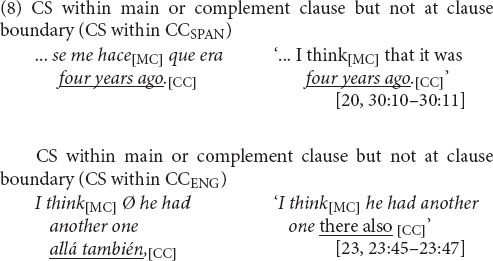
Also counted separately are cases of single-word items, mostly lone English nouns as in (9), which tend to be syntactically integrated into Spanish as the recipient language (Torres Cacoullos and Aaron, 2003: 466; Aaron, 2015; cf. Sankoff et al., 1990; Poplack, 2018).

Excluded are cases in which CS occurs following final intonation, that is, outside the target prosodic sentence, as in (10), where the complete syntactic unit in line (a) is extended with an “increment” in line (b) (cf. Ford et al., 2002: 16).

As seen in Figure 1, most of the main-and-complement clause sentences are unilingual, fairly evenly split between English (41%, n = 467) and Spanish (43%, n = 484). CS at the main and complement clause boundary occurs at a rate of 5.8% (n = 66). The remaining cases are of intra-clausal multi-word CS at other than the clause boundary [as in (8)] (n = 44) and single-word items (n = 75). The CS dataset is, to our knowledge, the largest [66 tokens of switching at the complement clause boundary, versus, for example, a total of 76 relative and subordinate clauses of all kinds (Poplack, 1980: 602)].
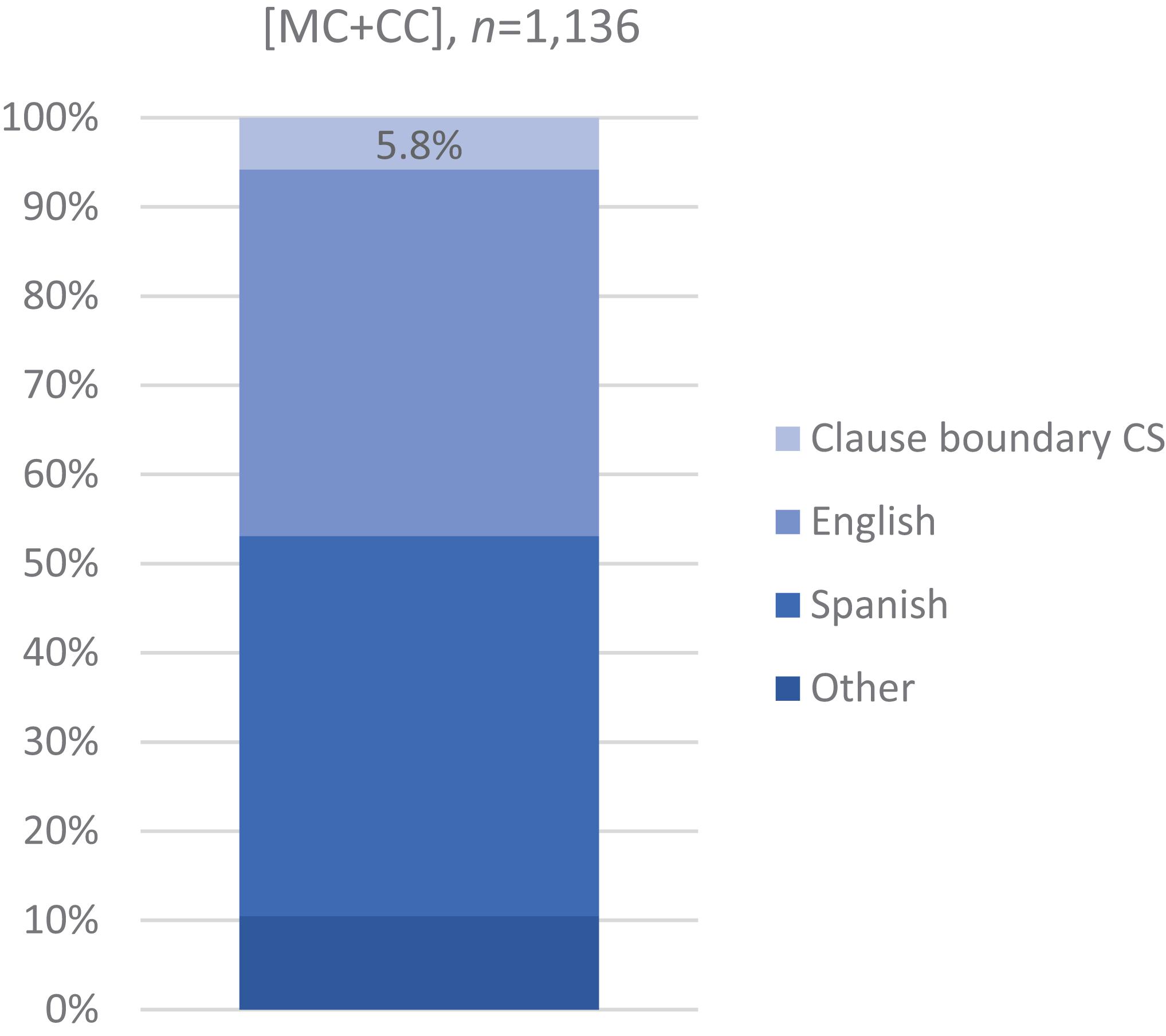
Figure 1. CS rate: Bilinguals’ main-and-complement clause sentences according to language (n = 1,136). Most main-and-complement clause sentences are unilingual, divided between English (41%, n = 467) and Spanish (43%, n = 484). The rate of CS at the main and complement clause juncture is 5.8% (n = 66). Other: [MC + CC] with CS other than at clause boundary or with single-word items.
To verify bilingual strategies, we will be comparing CS tokens with their unilingual as well as monolingual main and complement clause counterparts. Monolingual benchmarks are comparable speech corpora prosodically transcribed following the same protocols, the Santa Barbara Corpus of Spoken American English (Du Bois et al., 2000–2005) and the Corpus of Conversational Colombian Spanish (cf. Travis, 2005: 9–25).
As introduced above, the prosodic CS strategy states that bilinguals tend to prosodically distance a variably equivalent juncture of the two languages. The prediction here is based on what we know about monolingual main and complement clauses, which cross-linguistically tend to occur in the same IU (Croft, 1995: 861). Rates of realization of complement-taking verbs and their complement in one IU have been reported to be 78% (n = 844) in English and 68% (n = 328) in Spanish conversational data (Steuck, 2016: 81). Following the prosodic distancing hypothesis, we may thus predict that when CS occurs at the boundary between main and complement clauses, they will be integrated in the same IU at a lower rate than their unilingual and monolingual counterparts.
Precisely such is the result, seen in Figure 2. The tendency is for integration in the same IU in bilinguals’ unilingual sentences (English 78%, n = 467; Spanish 64%, n = 484), at rates closely matching their respective monolingual benchmarks (Steuck and Torres Cacoullos, 2019: 223, 227; a Fisher’s exact test comparing bilinguals’ unilingual English with monolingual English showed no difference in integration rates, p = 1.00 and, similarly, no difference between bilinguals’ Spanish and monolingual Spanish, p = 0.291; the difference in integration rates between monolingual English and Spanish, p = 0.0005, is maintained between bilinguals’ English and Spanish, p < 0.0001).
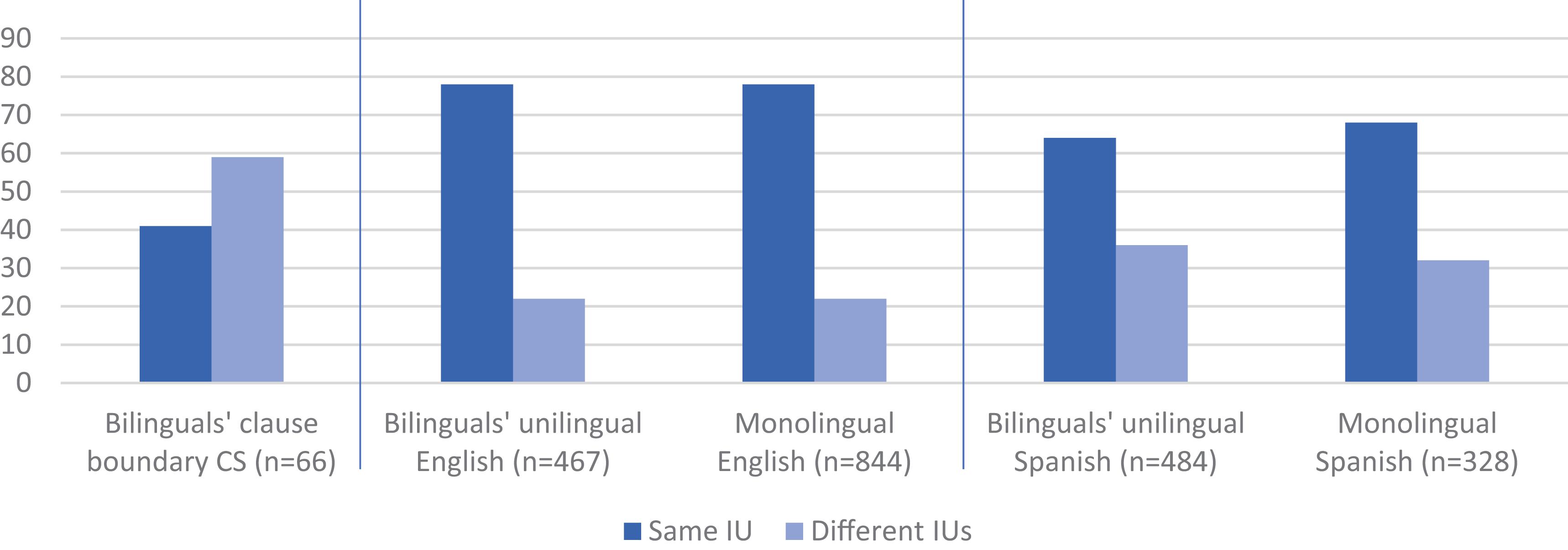
Figure 2. Prosodic realization of main-and-complement clause [MC + CC]:The tendency to occur in the same IU obtains in bilinguals’ unilingual sentences (English 78%, n = 467; Spanish 64%, n = 484), at rates closely matching their respective monolingual benchmarks (English 78%, n = 844; Spanish 68%, n = 328), but not when CS occurs at the main-and-complement clause boundary (41%, 27/66) (From Steuck and Torres Cacoullos, 2019: 223, 227).
But with CS between main and complement clause the tendency is the opposite, to occur in different IUs, as in (11) and (12) (with a rate of realization in one IU of just 41%, 27/66) (see Appendix 3). This prosodic separation strategy holds in both switching directions. For English to Spanish (11), the main and complement clauses appear in different IUs at a rate of 58% (18/31) and for Spanish to English (12), 60% (21/35).
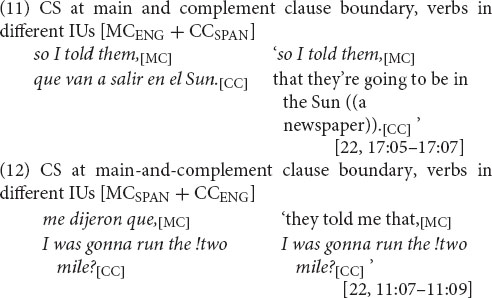
It is important to bear in mind that the prosodic distancing of main and complement clauses when CS occurs at their juncture is not a mere reflection of the general preference to switch across rather than within IUs (which holds across intra-sentential CS sites in aggregate, see section “Intra-sentential CS and Prosodic Structure”). When CS is intra-clausal, that is, when CS occurs as part of the main or complement clause—but not at their juncture—as in (13) (and [8] above), the tendency for prosodic integration stands (with a rate of realization of main and complement verbs in the same IU of 64%, n = 44) (Steuck and Torres Cacoullos, 2019: 227). This set of findings—that main-and-complement clause sentences with CS other than at the clause juncture are realized prosodically the same way as bilinguals’ unilingual main-and-complement clause sentences, which in turn align with their monolingual benchmark counterparts—is evidence that prosodic distancing is not due to some intrinsic cost of CS. Rather, prosodic distancing responds to variable equivalence, serving to mitigate the inconsistent compatibility at this particular juncture.

We hypothesized that a syntactic strategy for variably equivalent junctures in a language pair is to opt for the more readily available variant from one of the languages, so that the syntactic boundary between languages is realized as a site of equivalence. For the main-and-complement clause boundary, this is tested by the presence of the complementizer when CS occurs. Before considering those results, a prior result, depicted in Figure 3 (middle and right columns), is that bilinguals’ unilingual complementizer use adheres to the respective patterns of each of their languages. In bilinguals’ unilingual English main-and-complement clause complexes, complementizer that is variably present, at a rate of 27% (126/467), within the range reported for monolingual English (see section “Variable Equivalence” above). In their unilingual Spanish, complementizer que is always present, as in monolingual Spanish. We confirm, thus, that complementizer presence is indeed a site of variable equivalence for these speakers.
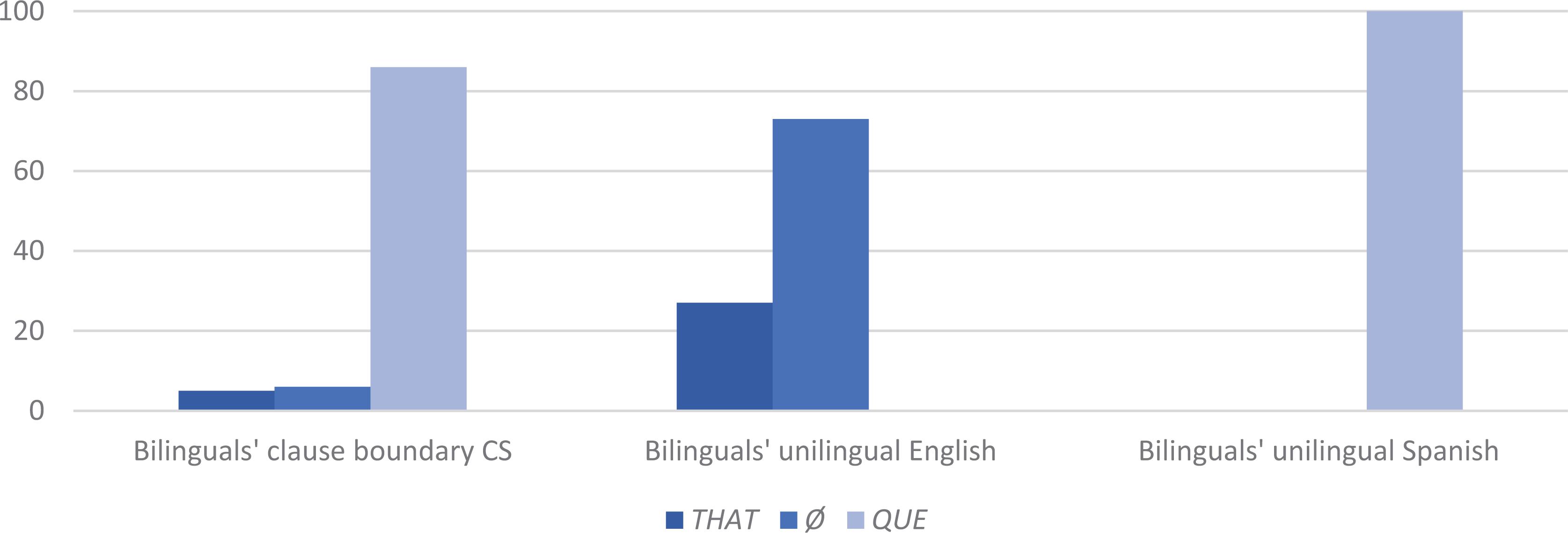
Figure 3. Use of complementizers according to main-and-complement clause language (n = 1,017): Bilinguals’ unilingual complementizer use adheres to the respective patterns of each of their languages (in unilingual English, complementizer that is variably present, at a rate of 27% (126/467); in unilingual Spanish, complementizer que is 100% present). With CS at the clause boundary, complementizer que predominates, at 86% (57/66).
Furthermore, besides adhering to monolingual rates, bilinguals’ English maintains the constraints on complementizer use. English complementizer that presence is subject to lexical, discourse and structural factors (see, e.g., Shank et al., 2016: 202–213; Wulff et al., 2018: 100–101 and references therein). The conditioning factors indicate that English that is used to demarcate clauses when both have semantic or propositional content (Torres Cacoullos and Walker, 2009: 29). Material intervening between the main clause verb and the complement clause favors the presence of that, as do lexical rather than pronominal subjects in the complement clause. Particular main-clause verbs, especially first-person subject and simple present-tense forms such as I think, I guess, I remember, in contrast, are associated with absence of that. Bilinguals’ English shows parallels with this linguistic conditioning of variable that presence, which is more frequent when there is intervening material than when there is not (46%, 52/112 vs. 21%, 74/355) and with other than first-person singular main clause subjects (58%, 65/113 vs. 17%, 16/353).
The remarkable result is that, despite the integrity of complementizer use in bilinguals’ unilingual English and Spanish as separate languages, at their juncture there is strong skewing in favor of one of the options, as depicted in Figure 3 (left set of columns). Given the nearly even numbers of English and Spanish unilingual main-and-complement clause complexes, we might have expected that with CS at the clause boundary, the distribution of complementizer options would be proportional: roughly 10% that, 40% Ø (complementizer absence), and 50% que. Instead, complementizer que predominates, at 86% (57/66). The remaining cases are 4 of complementizer absence, 3 of that, and 2 of that que.
An important aspect of this result is that of all instances of CS at the main and complement clause juncture, only 6% are with the Ø option—complementizer absence—as in (14) (compare (15)). The explanation is that the main and complement clause boundary does not occur in the absence of a complementizer in Spanish. The disproportionate preference for complementizer presence in CS, then, constitutes a reconstruction of equivalence between English and Spanish in word string patterns.
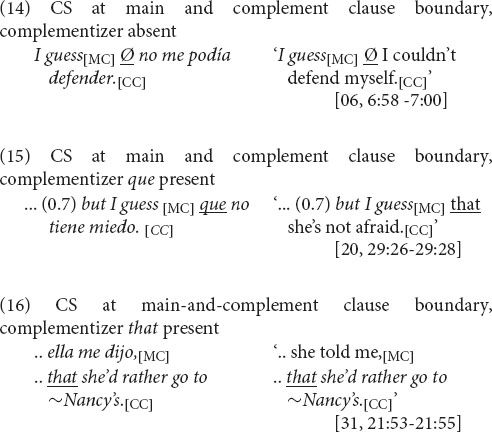
The other important aspect of this result is that, of the 94% of CS instances with the complementizer present, nearly all are with Spanish que, while instances with English that, as in (16), constitute only 5% (3/66). This is a genuine preference, not an accident of data distributions. As seen in Figure 4, CS goes from Spanish to English and English to Spanish in about even proportions (53%, 35/66 and 47%, 31/66). That is, in nearly half the instances of CS at the clause boundary, the direction is English to Spanish, and still Spanish que predominates over English that, at a rate of 96% (26/27). This is virtually identical to the rate of que when CS goes in the opposite direction, from Spanish to English, at 94% (31/33). (The number of observations in Figure 4 is 60, excluding cases of complementizer absence (n = 4) and of that que (n = 2).) A compatible result has been reported from an elicited oral production task, where subjects produced que more often than that whether the stimulus began in Spanish or English (Dussias, 2001: 33).
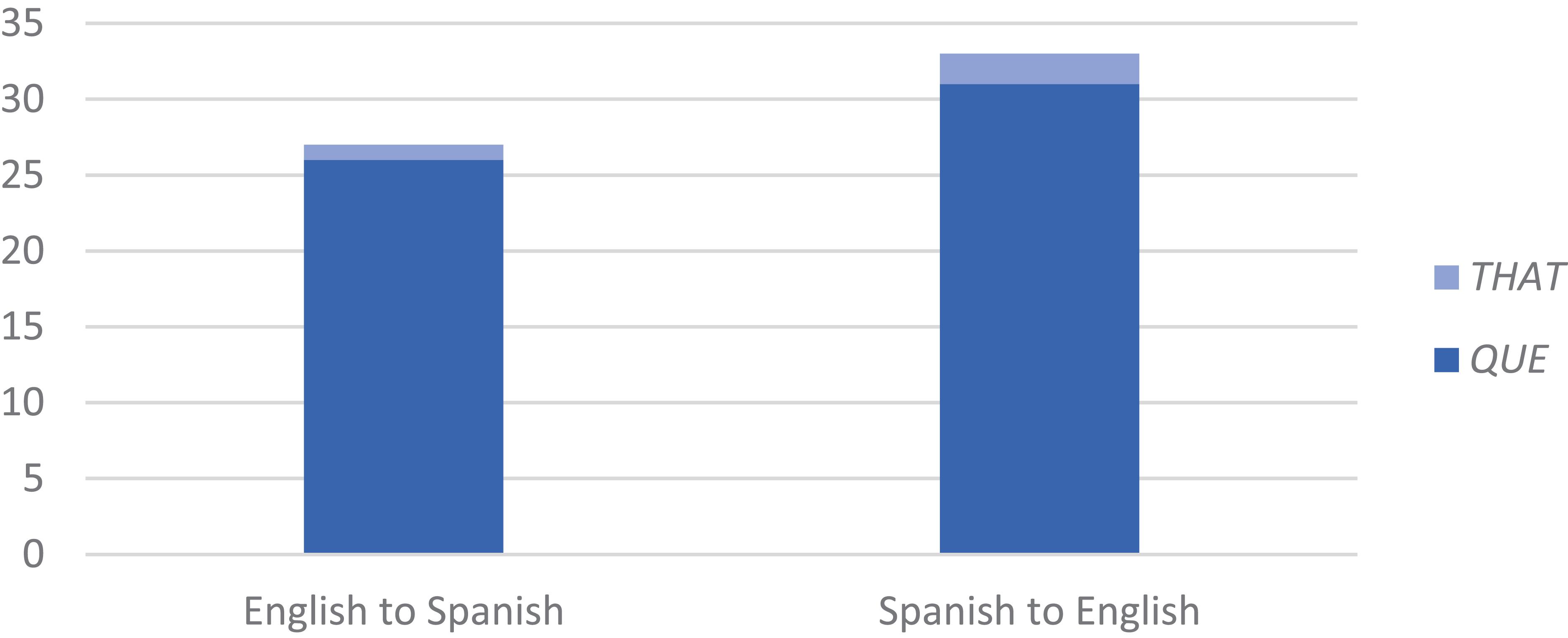
Figure 4. Use of complementizer according to CS direction (n = 60): Spanish que predominates over English that, regardless of CS direction and the language of the main verb, at a rate of 96% (26/27) when CS is from English to Spanish and 94% (31/33) when CS is from Spanish to English. CS goes from English to Spanish and Spanish to English in about even proportions (47%, 31/66 and 53%, 35/66).
Figure 5 now shows the positioning of the switch. This may be after the complementizer, such that main verb and complementizer are in the same language, as in (17), and at the complementizer, such that complementizer and subordinate verb are in the same language, as in (18). The positioning of CS is approximately even, occurring 52% (29/56) after, and 48% at the complementizer (left column in Figure 5). (The number of observations in Figure 5 is 56, not counting cases with an intervening clause between main and complement clauses (n = 4), for example, oh yeah I remember, .. cuando llegaba gente, que nos decía, ‘oh yeah I remember, .. when people would visit, that she would tell us,’ [03, 37:04]; counting these, the proportion of CS occurring after the complementizer is 53% (32/60).)
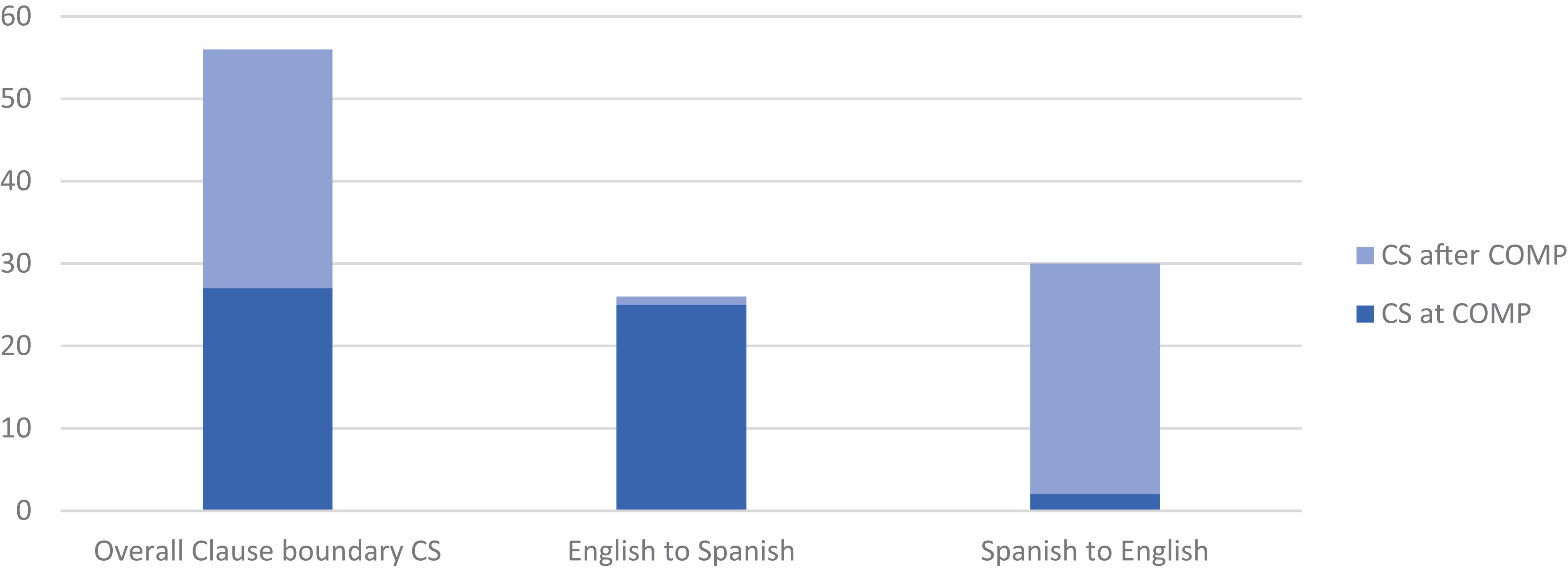
Figure 5. Position of CS at main-and-complement clause boundary—beginning at complementizer versus after complementizer—overall and according to CS direction (n = 56): The positioning of CS overall is approximately even, occurring 52% (29/56) after, 48% at, the complementizer; English to Spanish CS tends to occur at the complementizer, 96% (25/26), Spanish to English CS after the complementizer, 93% (28/30).
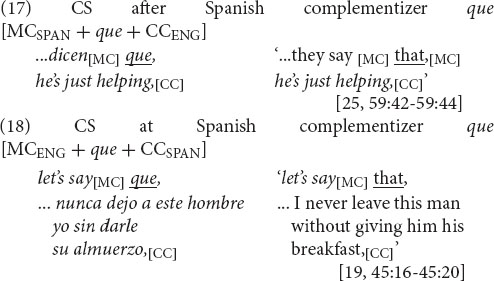
As also indicated in Figure 5, the positioning of the switch, at or after the complementizer, and the direction of the switch, are highly correlated: English to Spanish CS tends to occur at the complementizer, 96% (25/26), Spanish to English CS tends to occur after the complementizer, 93% (28/30). These patterns contradict constraints derived from (monolingual) syntactic theories and supported by introspective or elicited judgments, anecdotal observations or haphazardly collected examples. The generalization can be neither that “the complementizer [.] is in the same language as the main verb” (Di Sciullo et al., 1986: 8) nor that “the complementizer is in the language of the complement clause” (Belazi et al., 1994: 224). Rather, this correlation follows from bilinguals’ strong preference to use que for CS at the clause boundary—regardless of the language of either the main or the complement clause.
In sum, bilinguals do not overuse minor English option that, but select major Spanish option que. They prefer the Spanish complementizer regardless of CS direction. As predicted in accordance with the syntactic selection strategy for variable equivalence, [MCSPAN + que + CCENG] (n = 28) and [MCENG + que + CCSPAN] (n = 25) predominate over [MCSPAN + that + CCENG] (n = 2) and [MCENG + that + CCSPAN] (n = 1). With the structural adjustment of syntactic selection—preferential selection of a syntactic option from one of the languages—the syntactic boundary becomes one that occurs in both languages, and equivalence is restored.
Bilingual CS strategies are quantitative preferences and structural adjustments for switching at particular junctures of the two languages. Adopting a view of processing cost not as inherent to CS but as a relative concept, we zeroed in on particular structural junctures of the two languages: sites of variable equivalence, where word placement is not always realized in the same way in both languages. Such is the main-and-complement clause boundary in English and Spanish, where the complementizer is variably present in one language but categorically present in the other. Though, theoretically, bilinguals could resolve variable equivalence through grammatical convergence (e.g., by “dropping” Spanish que on the model of English that or by extending that on the model of que), in this bilingual community the conflict between the two languages remains intact (cf. Poplack and Levey, 2010).
The prosodic distancing strategy is to separate the boundary between languages, here via the appearance of the complement clause in a different prosodic unit from the main clause, disproportionately as compared with unilingual and monolingual benchmarks. Prosodic distancing mitigates the problem of variable equivalence by disconnecting the juncture of the languages where a word placement conflict may arise. The syntactic selection strategy is to recruit the more available option from one of the languages at the boundary with the other, here Spanish complementizer que. Choosing such a syntactic option bypasses the problem of variable equivalence, by reconstructing equivalence.
How to explain the disproportionate preference for the Spanish complementizer? One explanation would posit that Spanish is the Matrix Language (ML) providing the morpho-syntactic frame in main clauses, such that “a strong preference for the ML to supply ‘that-type’ complementizers at clause boundaries is predicted”; in other words, “whatever ML dominates in the discourse seems to preference complementizers from that language” (Myers-Scotton and Jake, 2009: 355)5. The prediction is not upheld half the time, no matter how the ML is assigned (Figure 5). The positioning of CS—at versus after the complementizer—is approximately even, such that the complementizer is in the same language as the complement clause as often as it is in the same language as the main verb.
Beyond the particular prediction, inconsistent with CS models assuming that one language dominates is, for one, that the distribution of main-and-complement clause sentences by language is about even between English and Spanish (Figure 1), which renders inconsequential such a posited asymmetry between the two languages within the corpus. Remember, too, that there is no overextension of that, unlike Spanish-speaking L2 learners (Wulff et al., 2018: 118): bilinguals’ English maintains monolingual English patterns for prosodic integration and for complementizer that rate (Figure 2, Figure 3). Furthermore, the bidirectionality of the multi-word CS indicates that these bilinguals have real choices, not imposed by language dominance (Figure 4; cf. Appendix 2). In sum, the distribution of clauses by language, patterns of language-internal variability, and directionality of CS in the northern New Mexico corpus would not justify conferring on one of the languages the status of an overarching matrix language.
Rather, the preference for the Spanish complementizer is a genuinely bilingual strategy, for which both languages come into play. Bilinguals opt for Spanish complementizer que to construct equivalence because it is the more available variant, according to a usage-based approach to linguistic structure and process (e.g., Bybee, 2010). How so? For one, que is the quantitatively more readily available option. In bilinguals’ cumulative linguistic experience, given the use of both their languages, que will be more frequent than that. This status of que as the major variant thanks to its greater frequency would not be inconsonant with an explanation that has been suggested for choosing que over that on the basis of a weaker bond between verb and complementizer in English than in Spanish (Dussias, 2002: 34).
Spanish que is also what we might call the more neutral option. English complementizer that has grammaticalized from its origins as a demonstrative pronoun and its diachronic trajectory may be one of increasing use, but it remains variable (Shank et al., 2016: 237; cf. Hopper and Traugott, 1993: 185–189). Variable that use is subject to discourse contextual factors such as the form-topicality of the complement clause subject, whereas Spanish que is an obligatory marker of a clause as a complement (Thompson and Mulac, 1991: 248; Torres Cacoullos et al., 2017, 79–81). The linguistic conditioning of that makes it a more meaningful—and less neutral—variant than que. The more context-independent Spanish complementizer is thus a more likely candidate than the probabilistically constrained that for constructing equivalence at the juncture of the two languages.
The syntactic selection strategy for CS may therefore be more precisely restated as follows:
Construct consistent equivalence by opting for the quantitatively more available and more discourse-neutral variant from one of the languages.
The implications for lab-based experiments on CS cost would follow from the dictum that “production predicts comprehension” (Hsiao and MacDonald, 2016: 87; cf. Johns et al., 2019: 599 and references therein). For English-Spanish bilinguals, we can predict that CS at the main-and-complement clause boundary will be more difficult to process relative to Intra-sentential CS elsewhere, for example, when the switch point is before a predicate adjective, an adverbial expression or a lexical direct object (see examples (3), (8), and (13)). Cost should be attenuated with distancing of the clause boundary by placing the clauses in separate prosodic units or, in written stimuli, perhaps through use of commas or appearance on separate lines. And we expect cost to be reduced in the presence of Spanish complementizer que compared with English that. Lab-based work could also investigate combinations of syntactic and prosodic options, for example, less-preferred that together with separation of the clauses.
More general hypotheses may be stated as follows. First, CS will be more difficult to process—by appropriate behavioral or neurophysiological responses (and with caveats concerning experimental design and participants’ bilingual practices)—at some boundaries than at others. Difficulty is modulated by variable word placement conflicts at the junctures of two languages. And second, at sites of variable equivalence CS will be less difficult when (1) the juncture of the two languages is prosodically distanced and (2) a frequent and neutral equivalence-restoring syntactic variant is selected, according to bilingual community conventions.
These findings emerge from the spontaneous language-combining behavior of bilinguals for whom using both languages and alternating between them is an everyday occurrence. It is bilinguals’ choices that enable us to discern CS strategies.
The datasets for this manuscript are not publicly available to protect participants against misunderstanding of local variants and the unintentional publication of stereotyping examples by those unfamiliar with the speech community. Unlike much of the data generated in lab-based bilingualism studies, sociolinguistic corpora are re-usable and citable. Such data are a more accurate representation of actual performance, sometimes of a highly personal nature in interactions with in-group interviewers, and often from members of close-knit minority language communities. In accordance with the ethical commitment to the speakers not to place the data in the public domain, individual requests for access may be directed to the author.
RTC contributed to the manuscript with 100%.
This work was supported by the National Science Foundation (BCS-1019112/1019122, 1624966).
The author declares that the research was conducted in the absence of any commercial or financial relationships that could be construed as a potential conflict of interest.
The author the editor JT-D and two referees for their comments on the manuscript, Trevor Bero and Jessica Vélez Avilés for data extraction and coding, Sonya Trawick for the appendix spectrograms, Dora LaCasse for thoughtful edits, and Joan Bybee, Shana Poplack, Jonathan Steuck, and Catherine Travis for fruitful discussions.
Aaron, J. E. (2015). Lone English-origin nouns in Spanish: the precedence of community norms. Int. J. Bilingual. 19, 459–480. doi: 10.1177/1367006913516021
Adamou, E., and Shen, X. R. (2019). There are no language switching costs when codeswitching is frequent. Int. J. Bilingual. 23, 53–70. doi: 10.1177/1367006917709094
Beatty-Martínez, A., Navarro-Torres, C., and Dussias, P. (2020). Codeswitching: a bilingual toolkit for opportunistic speech planning. Front. Psychol. 11:1699. doi: 10.3389/fpsyg.2020.01699
Beatty-Martínez, A., Valdés Kroff, J., and Dussias, P. (2018). From the field to the lab: a converging methods approach to the study of codeswitching. Languages 3:19. doi: 10.3390/languages3020019
Belazi, H. M., Rubin, E. J., and Toribio, A. J. (1994). Code switching and X-bar theory: the functional head constraint. Linguist. Inq. 25, 221–237.
Bentahila, A., and Davies, E. (1998). “Code-switching: an unequal partnership,” in Codeswitching Worldwide, ed. R. Jacobson (Berlin: Mouton de Gruyter), 25–49.
Bills, G. D., and Vigil, N. A. (2008). The Spanish Language of New Mexico and Southern Colorado: A linguistic Atlas. Albuquerque: University of New Mexico Press.
Chafe, W. (1994). Discourse, Consciousness and Time: The Flow and Displacement of Conscious Experience in Speaking and Writing. Chicago: University of Chicago Press.
Deuchar, M. (2005). Congruence and Welsh-English code-switching. Biling. Lang. Cogn. 8, 255–269. doi: 10.1017/s1366728905002294
Deuchar, M. (2020). Code-switching in linguistics: a position paper. Languages 5:22. doi: 10.3390/languages5020022
Di Sciullo, A.-M., Muysken, P., and Singh, R. (1986). Government and code-mixing. J. Linguist. 22, 1–24. doi: 10.1017/s0022226700010537
Du Bois, J. W., Schuetze-Coburn, S., Cumming, S., and Paolino, D. (1993). “Outline of discourse transcription,” in Talking Data: Transcription and Coding in Discourse, eds J. Edwards and M. Lampert (Hillsdale: Lawrence Erlbaum Associates), 45–89.
Du Bois, J. W., Chafe, W., Myer, C., Thompson, S. A., Englebretson, R., and Martey, N. (2000–2005). Santa Barbara Corpus of Spoken American English, Parts 1-4. Philadelphia: Linguistic Data Consortium.
Dussias, P. E. (2002). “On the relationship between comprehension and production data in codeswitching,” in Proceedings of the Romance Phonology and Variation: Selected Papers from the 30th Linguistic Symposium on Romance Languages, eds C. Wiltshire and J. Camps (Amsterdam: John Benjamins), 27–38. doi: 10.1075/cilt.217.05dus
Ford, C. E., Fox, B. A., and Thompson, S. A. (2002). “Constituency and the grammar of turn increments,” in The Language of Turn and Sequence, eds C. E. Ford, B. A. Fox, and S. A. Thompson (Oxford: Oxford University Press), 14–38.
Ford, C. E., and Thompson, S. A. (1996). “Interactional units in conversation: Syntactic, intonational, and pragmatic resources for the management of turns,” in Interaction and Grammar, eds E. Ochs, E. A. Schegloff, and S. A. Thompson (Cambridge: Cambridge University Press), 134–184. doi: 10.1017/cbo9780511620874.003
Fricke, M., Kroll, J. F., and Dussias, P. E. (2016). Phonetic variation in bilingual speech: a lens for studying the production-comprehension link. J. Mem. Lang. 89, 110–137. doi: 10.1016/j.jml.2015.10.001
Gonzales, M. D. (1999). “Crossing social and cultural borders: the road to language hybridity,” in Speaking Chicana: Voice, Power and Identity, eds L. Galindo and M. D. Gonzales (Tucson: University of Arizona Press), 13–38.
Green, D. W. (2011). Language control in different contexts: the behavioural ecology of bilingual speakers. Front. Psychol. 19:103. doi: 10.3389/fpsyg.2011.00103
Gumperz, J., and Hernández-Chávez, E. (1975). “Cognitive aspects of bilingual communication,” in El Lenguaje de los Chicanos, eds E. Hernández-Chávez, A. Cohen, and A. Beltramo (Arlington, VA: Center for Applied Linguistics), 154–163.
Guzzardo Tamargo, R. (2012). Linking Comprehension Costs to Production Patterns During the Processing of Mixed Language. Ph.D. thesis, State College, Pennsylvania.
Hofweber, J., Marinis, T., and Treffers-Daller, J. (2016). Effects of dense code-switching on executive control. Linguist Approach. Biling 6, 648–668. doi: 10.1075/lab.15052.hof
Hopper, P. J., and Traugott, E. (1993). Grammaticalization. 1st Edn, Cambridge: Cambridge University Press.
Hsiao, Y., and MacDonald, M. C. (2016). Production predicts comprehension: animacy effects in Mandarin relative clause processing. J. Mem. Lang. 89, 87–109. doi: 10.1016/j.jml.2015.11.006
Ihemere, K. (2016). Codeswitching in Igbo-English Bilingualism : A Matrix Language Frame Account. London: Bloomsbury.
Johns, M. A., Valdés Kroff, J., and Dussias, P. E. (2019). Mixing things up: how blocking and mixing affect the processing of codemixed sentences. Int. J. Bilingual. 23, 584–611. doi: 10.1177/1367006917752570
Joseph, B. (2016). “The semantics and syntax of complementation markers as an areal phenomenon in the Balkans, with special attention to Albanian,” in Complementizer Semantics in European Languages, eds K. Boye and P. Kehayov (Berlin: de Gruyter Mouton), 265–292.
Kootstra, G. J., Van Hell, J. G., and Dijkstra, T. (2010). Syntactic alignment and shared word order in code-switched sentence production: evidence from bilingual monologue and dialogue. J. Mem. Lang. 63, 210–231. doi: 10.1016/j.jml.2010.03.006
Labov, W. (1984). “Field methods of the project on linguistic change and variation,” in Language in Use: Readings in Sociolinguistics, eds J. Baugh and J. Sherzer (Englewood Cliffs: Prentice Hall), 28–53.
Labov, W. (2010). Principles of Linguistic Change: Cognitive and Cultural Factors. Oxford: Blackwell.
Lipski, J. (1978). “Code-switching and the problem of bilingual competence,” in Aspects of Bilingualism, ed. M. Paradis (Columbia, SC: Hornbeam Press), 250–264.
Litcofsky, K., and Van Hell, J. (2017). Switching direction affects switching costs: behavioral, ERP and time- frequency analyses of intra-sentential codeswitching. Neuropsychologia 97, 112–139. doi: 10.1016/j.neuropsychologia.2017.02.002
Mettouchi, A. (2008). “Kabyle/French codeswitching: a case study,” in Berber in Contact: Linguistic and Sociolinguistic Perspectives, eds M. Lafkioui and V. Brugnatelli (Cologne: Rüdiger Köppe Verlag), 187–198.
Muysken, P. (2015). “Déjà voodoo or new trails ahead? Re-evaluating the mixing typology model,” in Linguistic Variation: Confronting Fact and Theory, eds R. Torres Cacoullos, N. Dion, and A. Lapierre (New York, NY: Routledge), 242–261.
Myers-Scotton, C., and Jake, J. (2009). “A universal model of code-switching and bilingual language processing and production,” in The Cambridge Handbook of Linguistic Code-Switching, eds B. Bullock and A. Toribio (Cambridge: Cambridge University Press), 336–357. doi: 10.1017/cbo9780511576331.020
Ono, T., and Thompson, S. A. (1995). “What can conversation tell us about syntax?,” in Alternative Linguistics: Descriptive and Theoretical Modes, ed. P. W. Davies (Amsterdam: John Benjamins), 213–271.
Pérez-Leroux, A., O’Rourke, E., and Sunderman, G. (2014). “Language dominance and codeswitching asymmetries,” in Grammatical Theory and Bilingual Codeswitching, ed. J. MacSwan (Cambridge, Mass: MIT Press), 283–312. doi: 10.7551/mitpress/9780262027892.003.0012
Pfaff, C. (1979). Constraints on language mixing: intrasentential code-switching and borrowing in Spanish/English. Language 55, 291–318.
Poplack, S. (1980). “Sometimes I’ll start a sentence in Spanish y termino en español”: toward a typology of code-switching. Linguistics 18, 581–618.
Poplack, S. (2015). “Code Switching (Linguistic),” in International Encyclopedia of the Social and Behavioral Sciences, 2nd Edn, ed. J. D. Wright (Oxford: Elsevier), 918–925.
Poplack, S. (2018). Borrowing: Loanwords in the Speech Community and in the Grammar. Oxford: Oxford University Press.
Poplack, S., and Levey, S. (2010). “Contact-induced grammatical change: a cautionary tale,” in Language and Space: An International Handbook of Linguistic Variation, Vol. 1 Theories and Methods, eds P. Auer and J. E. Schmidt (Berlin: Mouton de Gruyter), 391–419. doi: 10.1515/9783110220278.391
Rodríguez Ricelli, A. (2018). “Espero estén todos. The distribution of the null subordinating complmentizer in two varieties of Spanish,” in Language Variation and Contact-induced Change. Spanish across Space and Time, eds J. King and S. Sessarego (Amsterdam: John Benjamins), 301–333.
Sankoff, D. (1988). “Sociolinguistics and syntactic variation,” in Linguistics: The Cambridge Survey (Vol. 4, Language: The Socio-Cultural Context), ed. F. Newmeyer (Cambridge: Cambridge University Press), 140–161. doi: 10.1017/cbo9780511620577.009
Sankoff, D. (1998). A formal production-based explanation of the facts of code-switching. Biling. Lang. Cogn. 1, 39–50. doi: 10.1017/s136672899800011x
Sankoff, D., and Poplack, S. (1981). A formal grammar for code-switching. Pap. Linguist. 14, 3–45. doi: 10.1080/08351818109370523
Sankoff, D., Poplack, S., and Vanniarajan, S. (1990). The case of the nonce loan in Tamil. Lang. Var. Chang. 2, 71–101. doi: 10.1017/s0954394500000272
Shank, C., Plevoets, K., and Van Bogaert, J. (2016). “A multifactorial analysis of that/ zero alternation: the diachronic development of the zero complementiser with think, guess and understand,” in Corpus-Based Approaches to Construction Grammar, eds J. Yoon and S. T. Gries (Amsterdam: John Benjamins), 201–240. doi: 10.1075/cal.19.08sha
Shenk, P. (2006). The interactional and syntactic importance of prosody in Spanish-English bilingual discourse. Int. J. Bilingual. 10, 179–205. doi: 10.1177/13670069060100020401
Silva-Corvalán, C. (1994). Language Contact and Change: Spanish in Los Angeles. Oxford: Clarendon Press.
Steuck, J. (2016). “Exploring the syntax-semantics-prosody interface: complement clauses in conversation,” in Inquiries in Hispanic Linguistics: From Theory to Empirical Evidence, eds A. Cuza, L. Czerwionka, and D. Olson (Amsterdam: John Benjamins), 73–94. doi: 10.1075/ihll.12.05ste
Steuck, J. (2018). The Prosodic-Syntactic Structure of Intra-Sentential Multi-Word Code-Switching in the New Mexico Spanish-English Bilingual Community. Ph.D. thesis, State College, Pennsylvania.
Steuck, J., and Torres Cacoullos, R. (2019). “Complementing in another language: prosody and code-switching,” in Language Variation - European Perspectives VII, eds J. Villena Ponsoda, F. Díaz-Montesinos, A.-M. Ávila-Muñoz, and M. Vida-Castro (Amsterdam: John Benjamins), 219–231.
Tagliamonte, S., and Smith, J. (2005). No momentary fancy! The zero ‘complementizer’ in English dialects. English Language and Linguistics 9, 289–309.
Tagliamonte, S., Smith, J., and Lawrence, H. (2005). No taming the vernacular! Insights from the relatives in northern Britain. Lang. Var. Chang. 17, 75–112.
Thompson, S. A., and Mulac, A. (1991). The discourse conditions for the use of the complementiser that in conversational English. J. Pragmat. 15, 237–251. doi: 10.1016/0378-2166(91)90012-m
Torres Cacoullos, R., and Aaron, J. E. (2003). Bare English-origin nouns in Spanish: rates, constraints, and discourse functions. Lang. Var. Chang. 15, 287–326.
Torres Cacoullos, R., LaCasse, D., Johns, M., and De La Rosa Yacomelo, J. (2017). El subjuntivo: Hacia la rutinización. Moenia 23, 73–94.
Torres Cacoullos, R., and Poplack, S. (2016). Code-Switching in Spontaneous Bilingual Speech. Alexandria, VA: National Science Foundation.
Torres Cacoullos, R., and Travis, C. E. (2018). Bilingualism in the Community: Codeswitching and Grammars in Contact. Cambridge: Cambridge University Press.
Torres Cacoullos, R., and Travis, C. E. (2020). “Code-switching and bilinguals’ grammars,” in The Routledge Handbook of Language Contact, eds E. Adamou and Y. Matras (London: Routledge), 252–274.
Torres Cacoullos, R., and Walker, J. A. (2009). On the persistence of grammar in discourse formulas: a variationist study of that. Linguistics 47, 1–43. doi: 10.1515/ling.2009.001
Travis, C. E. (2005). Discourse Markers in Colombian Spanish: A Study in Polysemy. Berlin: Mouton de Gruyter.
Travis, C. E., and Torres Cacoullos, R. (2013). Making voices count: corpus compilation in bilingual communities. Aust. J. Linguist. 33, 170–194. doi: 10.1080/07268602.2013.814529
Travis, C. E., and Torres Cacoullos, R. (2014). Stress on I: debunking unitary contrast accounts. Stud. Lang. 38, 372–404.
Treffers-Daller, J. (2005). Evidence for insertional codemixing: mixed compounds and French nominal groups in Brussels Dutch. Int. J. Bilingual. 9, 477–506. doi: 10.1177/13670069050090030901
Treffers-Daller, J. (2016). “Language dominance: the construct, its measurement and operationalization,” in Language Dominance in Bilinguals: Issues of Operationalization and Measurement, eds C. Silva-Corvalán and J. Treffers-Daller (Cambridge: Cambridge University Press), 235–265. doi: 10.1017/cbo9781107375345.012
Treffers-Daller, J. (2019). What defines language dominance? Annu. Rev. Linguist. 5, 375–393. doi: 10.1146/annurev-linguistics-011817-045554
Vergara, D. (2018). “Basque complementizers under the microscope: a Spanish/Basque code-switching approach,” in Code-Switching - Experimental Answers to Theoretical Questions: In Honor of Kay González-Vilbazo, ed. L. López (Amsterdam: John Benjamins), 223–256. doi: 10.1075/ihll.19.09ver
Wells, J. B., Christiansen, M. H., Race, D. S., Acheson, D. J., and MacDonald, M. C. (2009). Experience and sentence processing: statistical learning and relative clause comprehension. Cogn. Psychol. 58, 250–271. doi: 10.1016/j.cogpsych.2008.08.002
Wilson, D. V., and Dumont, J. (2015). The emergent grammar of bilinguals: The Spanish verb hacer ‘do’ with a bare English infinitive. Int. J. Bilingual 19, 444–458.
Wulff, S., Gries, S., and Lester, N. (2018). “Optional that in complementation by German and Spanish learners,” in What is Applied Cognitive Linguistics? Answers from Current SLA Research, eds A. Tyler and C. Moder (New York, NY: de Gruyter Mouton), 99–120. doi: 10.1515/9783110572186-004
Transcription Conventions (see Du Bois et al., 1993)∗.

∗Symbols for vocal noises, laughter, and lengthening have been removed for the purposes of readability.
New Mexico bilingual community members according to language preference, self-rating, and predominance, all speakers (n = 40) and, in second columns, those producing CS at main-and-complement clause boundary (n = 19).

∗ Speakers were categorized as “English predominant” if more than two-thirds of their total clause count (finite verbs) were English and “Spanish predominant” if more than two-thirds were Spanish, or else “Both” (total n clauses = 36,000), as a measure of relative level of use and activation. Preferred language and self-rating scores are not strongly correlated; language predominance does not correlate with reported language preference nor strongly with self-rating (on the pitfalls of transposing proficiency assessments into the community setting, see Torres Cacoullos and Travis, 2018: 58–72).
Occurrence in a single Intonation Unit and in separate IUs of main and complement clauses with CS at the clause boundary, after and at the complementizer (examples (4) and (18)).∗
∗ Delimiting IU boundaries is done perceptually (Ford and Thompson, 1996: 145–149). Features used by the transcriber include higher pitch at the beginning of the IU and a slower speech rate at the end (as with better in the first example), and pausing between IUs (in the second example).
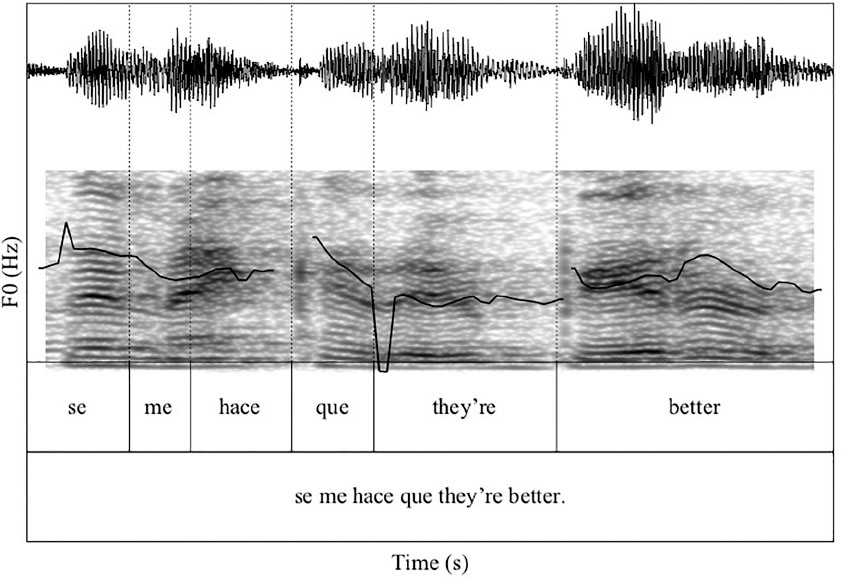
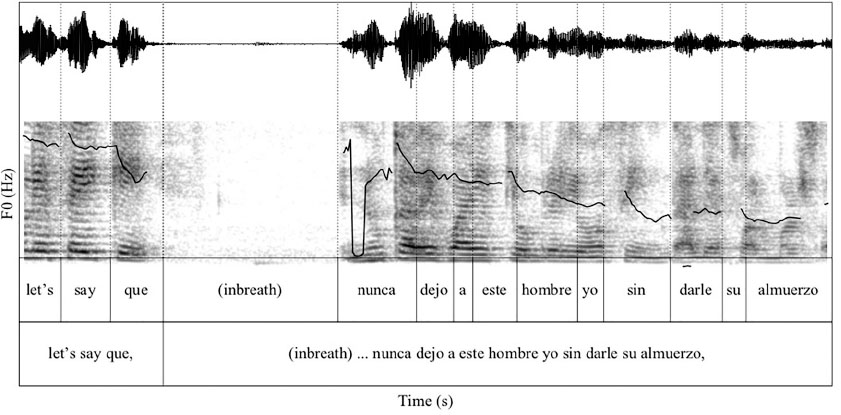
Keywords: code-switching, complementizers, equivalence constraint, prosodic variation, syntactic variation, processing cost
Citation: Torres Cacoullos R (2020) Code-Switching Strategies: Prosody and Syntax. Front. Psychol. 11:2130. doi: 10.3389/fpsyg.2020.02130
Received: 05 March 2020; Accepted: 30 July 2020;
Published: 23 September 2020.
Edited by:
Jeanine Treffers-Daller, University of Reading, United KingdomReviewed by:
Margaret Deuchar, University of Cambridge, United KingdomCopyright © 2020 Torres Cacoullos. This is an open-access article distributed under the terms of the Creative Commons Attribution License (CC BY). The use, distribution or reproduction in other forums is permitted, provided the original author(s) and the copyright owner(s) are credited and that the original publication in this journal is cited, in accordance with accepted academic practice. No use, distribution or reproduction is permitted which does not comply with these terms.
*Correspondence: Rena Torres Cacoullos, cmVuYUBwc3UuZWR1
Disclaimer: All claims expressed in this article are solely those of the authors and do not necessarily represent those of their affiliated organizations, or those of the publisher, the editors and the reviewers. Any product that may be evaluated in this article or claim that may be made by its manufacturer is not guaranteed or endorsed by the publisher.
Research integrity at Frontiers

Learn more about the work of our research integrity team to safeguard the quality of each article we publish.